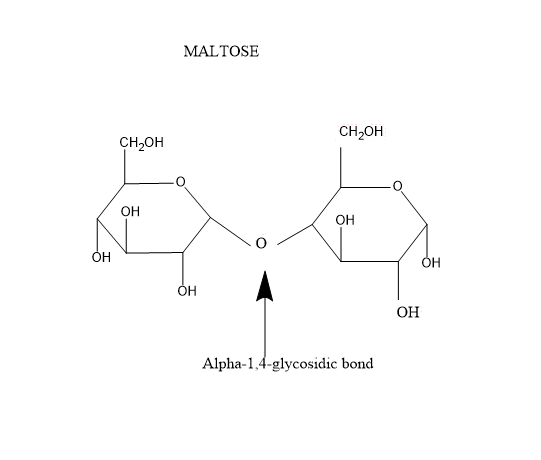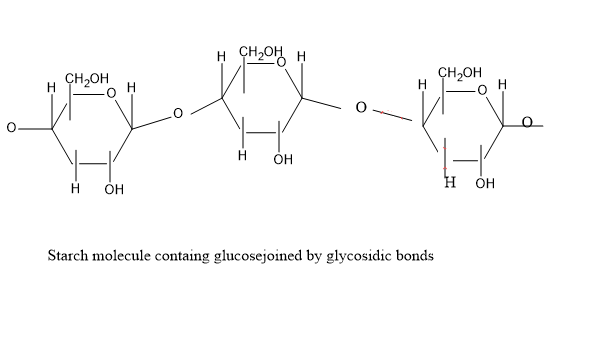
What is the name of the linkage connecting the monosaccharides in the polysaccharide ?
Answer
509.1k+ views
Hint :Monosaccharide is a carbohydrate composed of simple elements carbon $ C $ , hydrogen $ (H) $ , and Oxygen $ (O) $ . Two monosaccharide molecules form a bond that results in a disaccharide molecule. Some common examples of the disaccharides are – sucrose, maltose, and lactose.
When more than two monosaccharides join each other and form a bond that results in a polysaccharide.
Complete Step By Step Answer:
To solve this question first we need to understand carbohydrates and composition of the disaccharides or polysaccharides.
Carbohydrates are the naturally occurring compounds. These have four main categories – Monosaccharide, disaccharide, oligosaccharide and polysaccharide.
Carbohydrates are simple sugars and the disaccharides are known as “double sugars ``because they are composed of two monosaccharide units joined by ether bonds. They have $ \alpha ,\beta $ - glycosidic linkage. And the hemiacetal hydroxyl group resulting from the oxygen always participates in bond formation. Whether it is disaccharide or polysaccharide , in them monosaccharides are joined by Glycosidic linkage .
And the general formula for the disaccharides are $ {C_{12}}{H_{22}}{O_{11}} $ .
And the general formula for the polysaccharides are $ {C_6}{H_{10}}{O_5} $
Some common disaccharides are
$ sucrose = glucose + fructose $
$ Maltose = glucose + glucose $
$ Lactose = glucose + galactose $
Some common polysaccharides are - starch glycogen and cellulose .
Starch is made up of repeating units of glucose
Let’s look at the structure of the maltose (disaccharides) to understand its composition.
Maltose consists of two molecules of glucose joined by $ \alpha - 1,4 - $ glycosidic linkage. During the bond formation water molecules are released.

In case of maltose only one hemiacetal hydroxyl group participates in bond formation and the second one retains the properties of a reducing sugar.
Now , let's look at the polysaccharide starch consisting of glucose molecules joined by glycosidic bonds .

Note :
It is to keep in mind that the non – reducing nature of some disaccharides such as sucrose and trehalose is advantageous also as they confer these double sugars stability. And stability is the major criteria for the storage of the sugar, this is the reason why sucrose is also known as “table sugar”.
When more than two monosaccharides join each other and form a bond that results in a polysaccharide.
Complete Step By Step Answer:
To solve this question first we need to understand carbohydrates and composition of the disaccharides or polysaccharides.
Carbohydrates are the naturally occurring compounds. These have four main categories – Monosaccharide, disaccharide, oligosaccharide and polysaccharide.
Carbohydrates are simple sugars and the disaccharides are known as “double sugars ``because they are composed of two monosaccharide units joined by ether bonds. They have $ \alpha ,\beta $ - glycosidic linkage. And the hemiacetal hydroxyl group resulting from the oxygen always participates in bond formation. Whether it is disaccharide or polysaccharide , in them monosaccharides are joined by Glycosidic linkage .
And the general formula for the disaccharides are $ {C_{12}}{H_{22}}{O_{11}} $ .
And the general formula for the polysaccharides are $ {C_6}{H_{10}}{O_5} $
Some common disaccharides are
$ sucrose = glucose + fructose $
$ Maltose = glucose + glucose $
$ Lactose = glucose + galactose $
Some common polysaccharides are - starch glycogen and cellulose .
Starch is made up of repeating units of glucose
Let’s look at the structure of the maltose (disaccharides) to understand its composition.
Maltose consists of two molecules of glucose joined by $ \alpha - 1,4 - $ glycosidic linkage. During the bond formation water molecules are released.

In case of maltose only one hemiacetal hydroxyl group participates in bond formation and the second one retains the properties of a reducing sugar.
Now , let's look at the polysaccharide starch consisting of glucose molecules joined by glycosidic bonds .

Note :
It is to keep in mind that the non – reducing nature of some disaccharides such as sucrose and trehalose is advantageous also as they confer these double sugars stability. And stability is the major criteria for the storage of the sugar, this is the reason why sucrose is also known as “table sugar”.
Recently Updated Pages
Master Class 12 Business Studies: Engaging Questions & Answers for Success

Master Class 12 Economics: Engaging Questions & Answers for Success

Master Class 12 English: Engaging Questions & Answers for Success

Master Class 12 Maths: Engaging Questions & Answers for Success

Master Class 12 Social Science: Engaging Questions & Answers for Success

Master Class 12 Chemistry: Engaging Questions & Answers for Success

Trending doubts
What are the major means of transport Explain each class 12 social science CBSE

Which are the Top 10 Largest Countries of the World?

Draw a labelled sketch of the human eye class 12 physics CBSE

Explain sex determination in humans with line diag class 12 biology CBSE

The pH of the pancreatic juice is A 64 B 86 C 120 D class 12 biology CBSE

Give 10 examples of unisexual and bisexual flowers




